How Nature Works in Harmony Chapter Notes | Chapter Notes For Class 8 PDF Download
How does nature keep everything in balance—and what happens when that harmony is disturbed?
- From forests and rivers to animals, people, and the land itself, every part of nature is interconnected.
- Sometimes, when forests are cut down or rainfall changes, animals like elephants lose their homes and food, forcing them to move into farms or villages, leading to new problems.
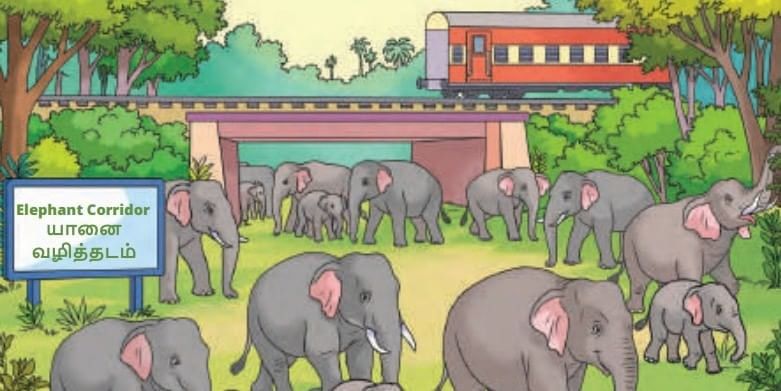 Elephants moving in search of food and shelter
Elephants moving in search of food and shelter - Even small changes in one part of nature can affect everything else around it.
In this chapter, you’ll explore how water, sunlight, plants, animals, and even humans are all linked in a web of relationships. You’ll discover why balance in nature is so important, how living things depend on each other, and how human actions can impact the whole system—for better or worse. Let's get started!
How Do We Experience and Interpret Our Surroundings?
Different habitats have different kinds of plants and animals
Habitat:
- A habitat is the place where an organism lives.
- It provides the surroundings and conditions an organism needs to survive.
- Habitats can be small (like tree bark) or large (like a pond or forest).
Diversity in Habitats:
- Different habitats have different kinds of plants and animals (living beings).
- Organisms adapt to survive in their specific habitats.
Activity: Explore two nearby habitats and identify both the living organisms and the non-living components in each.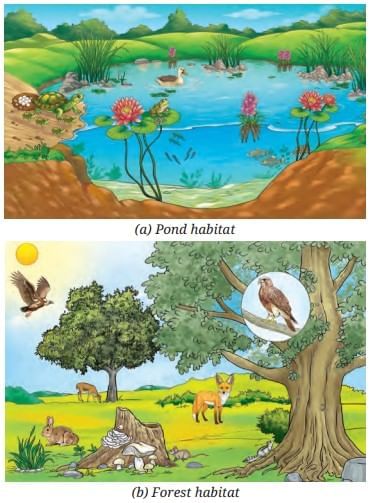
- Select two nearby habitats (e.g., a pond and a forest).
- List the living and non-living components in each habitat.
Common Characteristics of Habitats
Both habitats (like a pond and a forest) have:
- Living beings (biotic components): plants, animals, and other organisms.
- Non-living things (abiotic components): air, water, sunlight, soil, temperature, stones, etc.
Similarities:
- Both have biotic and abiotic components.
Differences:
- The types of living beings vary (e.g., fish in a pond, trees in a forest).
- The types of non-living components also differ (e.g., more water in a pond, more soil and air in a forest).
Biotic and Abiotic Components
- Biotic components: All living things in a habitat (plants, animals, microbes).
- Abiotic components: All non-living things in a habitat (sunlight, air, water, soil, temperature).
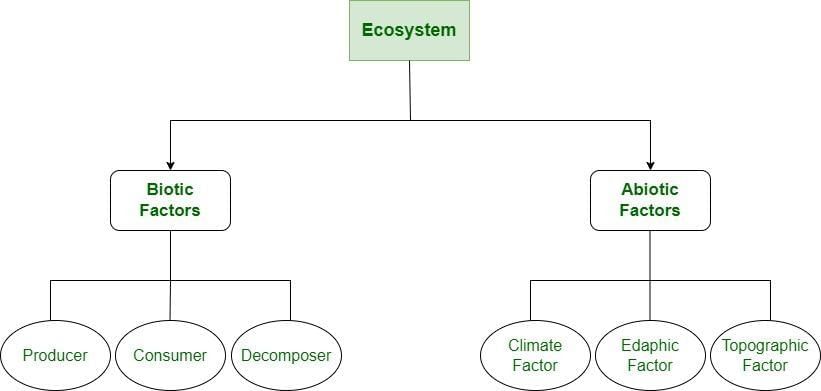
Why do some organisms live on land and others in water?
- Every organism needs certain conditions to survive, such as food, water, oxygen, shelter, and space.
- Example: Fish live in ponds because they get food, oxygen, and shelter there. Pond water provides both biotic needs (food from plants/animals) and abiotic needs (oxygen from water).
- Many other creatures (frogs, turtles, snakes, insects, birds, plants) share the pond. Each interacts with others and with the non-living parts of the habitat.
Coexistence and Harmony in Habitats
- Each habitat has its own unique mix of living (biotic) and non-living (abiotic) components, like air, sunlight, water, soil, and temperature.
- Different species in the same habitat might use resources differently: For example, in a forest, a snake may be active at night, while a rodent is active during the day—helping both survive in the same place but at different times.
Who All Live Together in Nature?
Population
- Definition: A population is a group of the same kind of organisms (same species) living together in a specific habitat at a given time.
- Example: All the fish of the same species in a pond form a fish population.
How Do We Measure Population?
To find the population of a certain plant or animal, you:
- Mark a fixed area (for example, 1m × 1m in your school garden).
- Count the number of each type of organism (plants or animals) present in that area.
- Record this information as the population for that type of organism in that particular area and time. Population means the number of individuals of a particular kind (species) living in a defined area at a certain time.
Community
- A community is formed by different populations (different types of plants, animals, and microorganisms) living together and interacting in the same habitat.
- It includes all living (biotic) components of the habitat.
Habitat
- Definition: A habitat is the physical place or environment where an organism lives.
- If there is only one type of organism in a habitat, there will be competition for resources like food, water, and space. This can cause shortages and make it hard for other creatures to survive.
- Diversity in a habitat (many types of organisms living together) helps maintain a balance and supports survival by providing different roles and interactions.
Pollination
- Flower Structure: Flowers have sepals, petals, stamens (male part), and carpels (female part).
- Pollination: The process of transferring pollen grains from the stamen of one flower to the carpel of the same or another flower.
- How it happens: Wind, water, insects, bats, and birds help carry pollen.
- Why it matters: Pollination is essential for fruits and seeds to form.
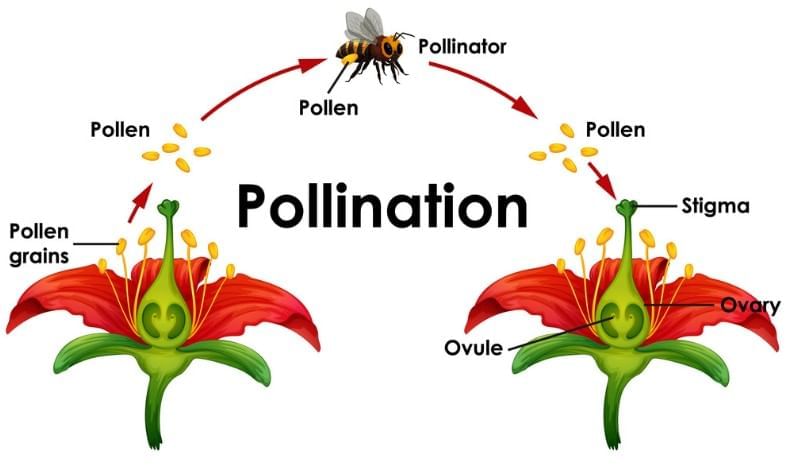
Does Every Organism in a Community Matter?
Yes! Every organism in a community plays an important role, helping maintain balance and supporting the survival of other organisms. Here’s how the activities and scientific studies help us understand this:
Explanation Using the Pond Example:
- Pond A (with fish): There are fewer dragonflies because fish eat the dragonfly larvae in the pond.
- Pond B (without fish): There are more dragonflies since nothing eats their larvae.

What happens next?
- Dragonflies are predators of bees, butterflies, and other insects that help pollinate flowers.
- Fewer dragonflies in Pond A means more bees and butterflies can survive and pollinate the flowers.
- More pollinators = more pollination, which leads to more flowers producing seeds and more plants.
Scientific studies confirm this: researchers found that plants around ponds with fish were better pollinated than those around ponds without fish, mainly due to this chain of effects.
 What Does This Show?
What Does This Show?
- Organisms are interconnected. The presence or absence of one type (like fish) can affect many others (like pollinators and plants).
- Every member of a community has a role (niche): Fish control dragonfly populations, dragonflies affect pollinators, pollinators are essential for plant reproduction, and plants provide food and shelter for all.
- This is known as a food web or ecological balance, where changes in one group lead to effects (sometimes called a “cascade”) throughout the community.
Impact of Overfishing by Humans
- Overfishing removes too many fish from ponds or oceans.
- If too many fish are taken away, dragonfly numbers might rise because their predators have gone. This could lower the number of pollinators, resulting in less pollination for nearby plants.
- Removing key species like fish upsets the delicate balance of the community, affecting not just other animals but also plants and even the non-living (abiotic) environment.
What Are the Different Types of Interactions Among Organisms and their Surroundings?
Organisms do not live alone. They constantly interact with both living (biotic) and non-living (abiotic) components in their environment.
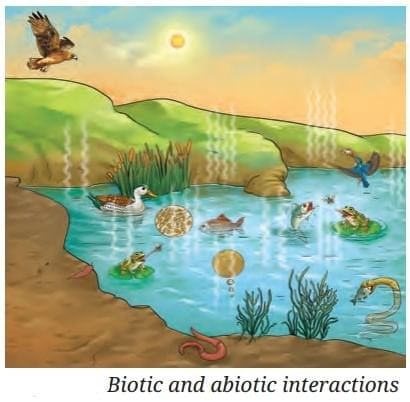
1. Interactions Between Biotic and Abiotic Components
Definition: Interactions between living things and non-living things in their environment.
Examples:
- Plants need sunlight (abiotic) for photosynthesis, water and soil for growth, and air for respiration.
- Earthworms live in moist soil.
- Fish lay eggs in water (abiotic).
- Soil provides nutrients for plants.
2. Interactions Among Abiotic Components
Definition: Interactions between non-living things, which affect the conditions of a habitat.
Examples:
- Sunlight warms up the day, increasing the temperature.
- Water evaporation happens faster in strong sunlight.
- Air currents create gentle waves on the water.
3. Interactions Among Biotic Components
Definition: These are the relationships between living organisms in a community.
Examples:
- Frogs eat insects (food chain).
- Water snakes eat fish.
- Frogs and fish compete for larvae.
- Many microbes (tiny living beings) interact in the pond, breaking down dead material.
- Plants provide food and shelter for animals.
- Mushrooms (fungi) decompose dead plants and animals.
The Concept of Ecosystem
An ecosystem is made up of all the living (biotic) and non-living (abiotic) things in a particular area and all the interactions among them. 
- Aquatic (water-based) ecosystems include ponds, rivers, and lakes
- Terrestrial (land-based) ecosystems include forests, grasslands, and farmlands.
- Ecosystems can overlap—for example, a river running through a forest.
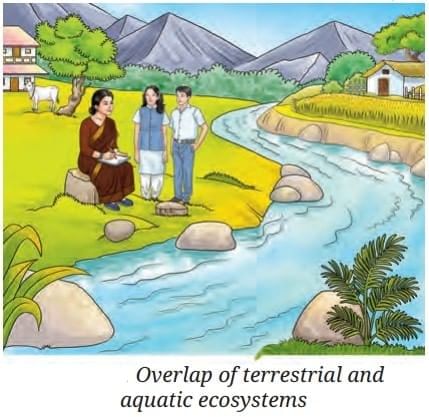
Types of Consumers and Producers
- Producers (Autotrophs): Make their own food (usually plants via photosynthesis).
- Consumers (Heterotrophs): Depend on others for food.
- Herbivores: Eat only plants (deer, horse).
- Carnivores: Eat only animals (vulture, shikra).
- Omnivores: Eat both plants and animals (fox, mouse). - Decomposers: Organisms like mushrooms and bacteria that feed on dead plants and animals, recycling nutrients back into the ecosystem.
Who Eats Whom?
Food Chain: A food chain is a simple sequence showing “who eats whom” in an ecosystem.
Example (Grassland Ecosystem):
1. Grass → Hare →Tiger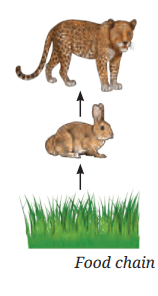 Grass is eaten by the hare; hare is eaten by the tiger.
Grass is eaten by the hare; hare is eaten by the tiger.
2. Grass → Grasshopper → Frog → Snake → Eagle
Here, each organism is eaten by the next one in the chain.
 Trophic Levels
Trophic Levels
Each organism in a food chain occupies a specific position, called a trophic level:
- First trophic level: Producers (plants, e.g., grass, millet)
- Second trophic level: Herbivores (organisms that eat plants, e.g., hare, mouse)
- Third trophic level: Small carnivores (those that eat herbivores, e.g., frogs)
- Fourth trophic level (and above): Large carnivores or top predators (e.g., eagle, hawk, fox)
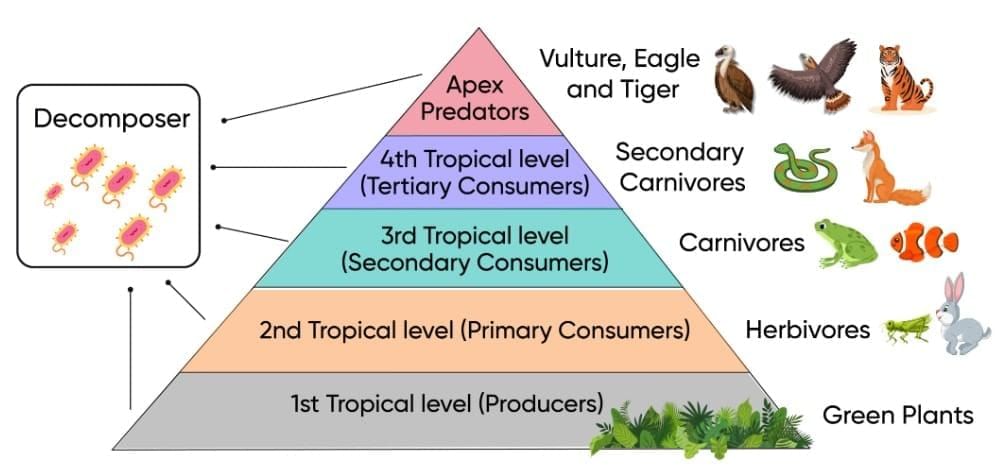 Trophic Level Pyramid
Trophic Level Pyramid
Ecological Pyramid
- When you count the number of organisms at each level (e.g., many grasses, fewer mice, only one eagle), and arrange these numbers with the highest at the base and lowest at the top, you get a pyramid shape.
- Producers are always the base, and top predators are at the top, indicating energy loss at each step.
Food Web
In reality, feeding relationships are not simple chains—they’re much more complex, forming a food web.
- The grass can be eaten by rabbit or mouse.
- Grasshoppers can be eaten by the bird or frog.
- Owls can eat mice or frogs.
Because each organism may be eaten by two or more types of organisms, the food chains overlap and link together, making a web.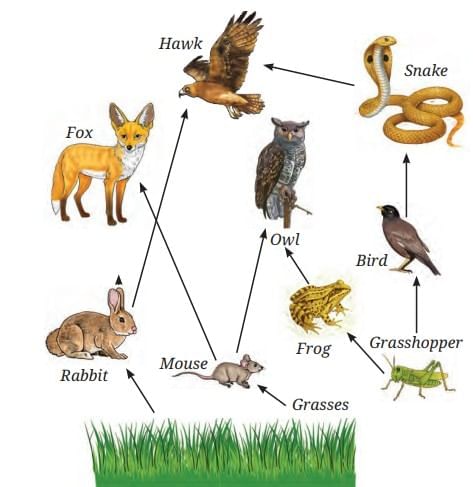 Food Web
Food Web
What Happens to Waste in Nature?
What are decomposers?
- Definition: Decomposers are organisms that break down dead plants, animals, and animal waste into simpler substances, returning nutrients to the soil.
- Examples: Mushrooms (a type of fungi), bacteria, beetles, and flies.
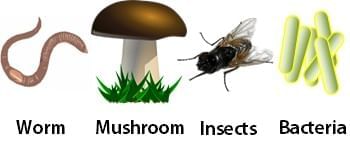 Examples of Decomposers
Examples of Decomposers
How Decomposition Works
- When plants, animals, or their waste die, decomposers feed on them.
- Fungi (like mushrooms) and bacteria break down complex substances in these dead materials into simpler forms.
- Beetles and flies often feed on things like animal dung (e.g., elephant dung), breaking it down further.
- This entire process is called decomposition.
Importance of Decomposers
- Nutrient Recycling: Decomposition returns important nutrients to the soil, which plants use to grow.
- Balance in Nature: Decomposers prevent the buildup of dead materials and waste in the environment.
- No Waste in Nature: Nothing truly goes to waste in nature—everything is reused in one form or another thanks to decomposers.
- Saprotrophs: Another name for decomposers. Sapro means "rotten," and troph means "food."
What are migratory birds?
- Birds that travel thousands of kilometers between different habitats and countries to avoid harsh climates or find food.
- Example: Demoiselle Cranes visit Khichan village in Rajasthan every winter.
Roles of Migratory Birds
- Enhance Beauty: Add color and vibrancy to habitats.
- Ecosystem Balance: Act as pollinators (helping flowers reproduce) and seed dispersers, linking different habitats.
- Pest Control: Feed on insect pests, helping farmers by reducing crop damage.
How Does One Change Lead to Another?
If plants in a pond die (e.g., due to pollution), then:
- Less oxygen is produced in the water.
- Fish population declines, as they need oxygen.
- Fewer fish means more insects (fish usually eat them).
- Extra insects spread to nearby farms and harm crops.
- Farmers use more pesticides, which further harms the environment.
One small change (like plant death) causes a chain reaction or “cascading effects” through the ecosystem.
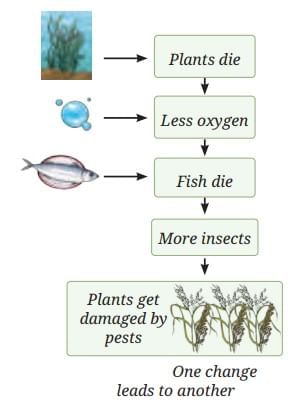
Effects of Human Intervention: The Frog Leg Export Story
- In the 1980s, India exported a huge number of Indian bullfrogs.
- This reduced frog populations.
- Fewer frogs meant more insects, including pests in farms.
- Farmers then used more pesticides, harming the environment, water, soil, and health of living beings.
- The Government banned frog-leg exports to help restore balance.
Ecosystem Balance
- Interactions between organisms and their environment keep populations and resources stable—this is called ecological balance.
- This balance is always changing (dynamic), but large disruptions (such as overuse, pollution, loss of species) can harm it.
How Do Interactions Maintain Balance in Ecosystems?
Besides feeding relationships, organisms also compete for common resources like food, water, physical space, or sunlight. This competition helps control population size and keeps the ecosystem balanced. Without it, one species could multiply too much causing an imbalance in the ecosystem
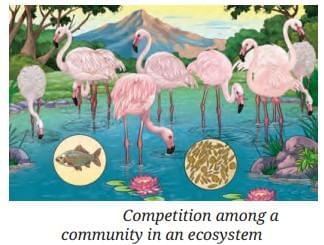
Other Relationships:
- Mutualism: Both organisms benefit (e.g., bees and flowers).
- Commensalism: One benefits, the other is unaffected (e.g., orchids on trees).
- Parasitism: One benefits, the other is harmed (e.g., ticks on dogs).
Benefits of an Ecosystem
- Forests: Provide clean air, fertile soil, food, timber, medicines, and beauty.
- Water bodies: Give water and food.
- All ecosystems: Offer aesthetic value, recreation, and support human well-being.
- Mangroves (e.g., Sundarbans): Protect against floods and storms, absorb carbon dioxide, support unique wildlife; recognized as a World Heritage Site.
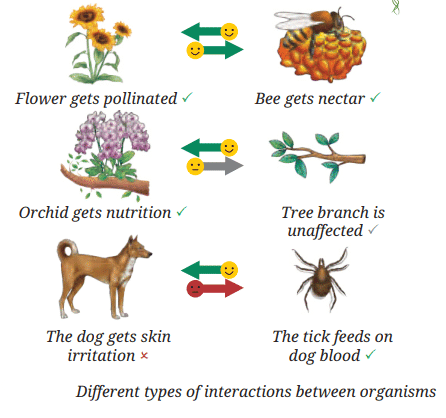
Threats to Ecosystems
- Deforestation, pollution, unsustainable land use, and illegal hunting are harming all types of habitats.
- The Sundarbans mangroves are under threat from wood cutting, pollution, and resource overuse.
- Such activities disrupt natural cycles and reduce biodiversity.
How To Protect Ecosystems
- Protected Areas: Such as national parks, biosphere reserves, and sanctuaries conserve habitats and wildlife. Examples: Jim Corbett, Manas, Nilgiri Biosphere Reserve, Chilika Lake.
- Community Action: People must work together to conserve resources, avoid pollution, and preserve natural areas.
Human-Made (Artificial) Ecosystems
- Examples: Farms, fish ponds, parks.
- When managed well, they can help reduce pollution, support biodiversity, and provide recreational spaces.
- Need: Continuous care and human management.
What Are the Benefits of an Ecosystem?
Ecosystems consist of biotic (living) and abiotic (non-living) components that depend on each other to support life processes.
Humans benefit from ecosystems in many ways:
- Forests provide fresh air, fertile soil, food, fibres, timber, and medicines.
- Aquatic ecosystems provide water and food.
- Ecosystems also offer aesthetic (beauty) and recreational (enjoyment) value.
- This supports human well-being and shows the close connection between nature and humans.
- However, overusing or misusing natural resources disturbs the balance in nature.
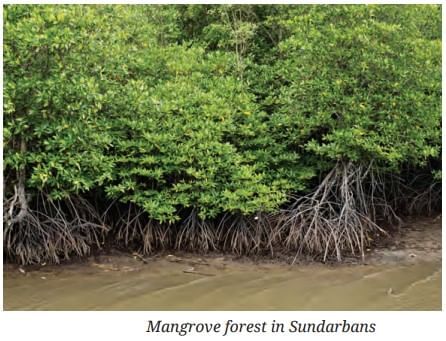
Real-Life Example: The Sundarbans – A Threatened Ecosystem
- The Sundarbans have the largest mangrove forests in the world.
- Located where the Ganges and Brahmaputra Rivers meet, between India and Bangladesh.
- Home to various flora (plants) and fauna (animals), many of which are endangered.
- Protects against storms and floods by slowing down strong winds and waves.
- Trees absorb carbon dioxide from the air and release oxygen.
- Declared a World Heritage Site by UNESCO (United Nations Educational, Scientific and Cultural Organization) in 1987 due to its importance.
Threats
- Mangrove trees are cut for fuelwood and farming.
- Illegal hunting and overuse of forest resources threaten wildlife.
- Pollution from industrial waste and untreated sewage damages water and habitat.
- These human activities disrupt the natural functioning of ecosystems.
Other Threatened Ecosystems in India
Ecosystems across India (forests, rivers, scrublands, wetlands, grasslands, coastal areas) are under threat.
Problems:
- Deforestation (cutting trees).
- Overuse of natural resources.
- Spread of invasive species (non-native plants/animals that harm locals).
- Unsustainable land use.
- Pollution.
Call to Action: Think about actions you and your community can take to protect forests, rivers, and wetlands to stop damaging them.
Protected Areas for Conservation
- Definition: Protected areas are parts of land or water set aside to conserve wildlife and their habitats.
- India has many protected areas: national parks, wildlife sanctuaries, biosphere reserves, and community conserved areas.
- Benefits: They protect entire habitats, including endangered animals, birds, and rare plants.
Famous Examples:
- Jim Corbett National Park (Uttarakhand).
- Manas National Park (Assam).
- Nilgiri Biosphere Reserve (Western Ghats).
- Chilika Lake (Odisha).
- Eaglenest Wildlife Sanctuary (Arunachal Pradesh).
- Hemis National Park (Leh).
- Keibul Lamjao National Park (Manipur).
- Pirotan Island Marine National Park (Gujarat).
- Protected areas play a big role in saving nature for future generations.
Our Scientific Heritage
- The ancient text Vrikshayurveda emphasizes soil health and nourishment.
- It advocates for continuous soil nourishment through organic manure like Kunapa Jala (a liquid fertilizer made from animal and plant waste by fermentation, which breaks complex substances into simpler ones) and other composted materials.
Human-Made Ecosystems
- Humans create artificial ecosystems like fish ponds, farms, and parks to meet their needs.
- When well-designed, they reduce pollution, support biodiversity (variety of life), and provide recreational spaces.
Unlike natural ecosystems, these need human care and management.
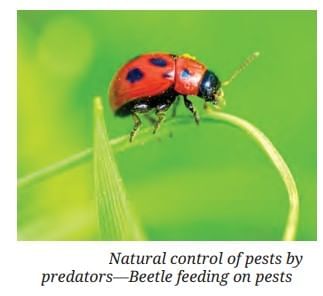
How Do Healthy Ecosystems Serve Our Farms?
- Farming is a major livelihood in India but can become unsustainable without environment-friendly practices.
- Humans have practiced farming for thousands of years to grow food.
- As population grew, dependence on agriculture increased.
- Between 1950 and 1965, India faced a food crisis due to low crop production.
- In the mid-20th century, the Green Revolution used tractors, machines, synthetic fertilizers, and pesticides to increase food production.
However, these methods are now seen as unsustainable due to:
- Overuse of synthetic chemicals.
- Excessive groundwater extraction.
- Growing only one type of crop (monoculture) for commercial gain.
Harms to Environment and Health:
- Overusing pesticides and monoculture lead to soil degradation (loss of quality).
- Reduces soil fertility by decreasing friendly microorganisms and organic matter (humus), which binds soil particles.
- Without humus, soil erodes easily.
- Reduces natural predators, increasing pest populations
- Heavy irrigation and repeated ploughing disturb soil organisms like earthworms and snails, important for ecological balance.
- Pests may develop resistance to pesticides, making control harder.
- Monoculture reduces crop diversity and affects pollinators (e.g., bees), crucial for food production.
- Understanding ecosystems helps adopt sustainable farming.
Some farmers explore organic and natural methods to reduce synthetic fertilizers and minimize interference in natural ecosystems.
Key Terms to Remember
- Habitat: A place that provides the right conditions for an organism to live and grow.
- Components of Habitats: Habitats consist of biotic components (plants, animals, microbes) and abiotic components (air, water, soil, temperature).
- Ecosystem: The interaction between biotic components and abiotic components in an area, forming a balanced system.
- Types of Ecosystems: Ecosystems can be terrestrial (such as forests, grasslands, deserts) or aquatic (such as ponds, lakes, seas, oceans).
- Classification of Organisms: Organisms are often classified as producers (plants), consumers (herbivores, carnivores, omnivores), and decomposers (bacteria, fungi).
- Producers: Organisms like plants that make their own food.
- Consumers: Organisms that eat plants or animals for energy.
- Decomposers: Organisms like bacteria and fungi that break down dead matter and recycle nutrients back into the ecosystem.
- Food Chains: Sequences that depict who eats whom in an ecosystem.
- Food Webs: Interconnected food chains showing complex feeding relationships in an ecosystem.
- Trophic Levels: The positions that different organisms occupy in a food chain, indicating their role in energy transfer.
- Mutualism: A relationship between organisms where both benefit.
- Commensalism: A relationship where one organism benefits and the other is unaffected.
- Parasitism: A relationship where one organism benefits and the other is harmed.
- Benefits of Ecosystems: The advantages ecosystems provide, which are crucial for human survival and well-being, including clean air, water, food, medicine, and climate regulation.
- Threats to Ecosystems: Human activities such as pollution, deforestation, habitat loss, climate change, invasive species, and overexploitation of natural resources that endanger ecosystems.
- Conservation of Ecosystems: Efforts to protect ecosystems, such as establishing national parks and sanctuaries, which are vital for preservation
FAQs on How Nature Works in Harmony Chapter Notes - Chapter Notes For Class 8
| 1. How do we perceive our environment through our senses? |  |
| 2. What role do different organisms play in natural ecosystems? |  |
| 3. How do living beings depend on each other in nature? |  |
| 4. What is the significance of biodiversity in ecosystems? |  |
| 5. How can human activities impact natural ecosystems? |  |
















